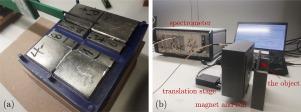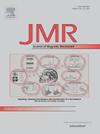结构紧凑的移动式杂散场核磁共振传感器
IF 1.9
3区 化学
Q3 BIOCHEMICAL RESEARCH METHODS
引用次数: 0
摘要
本文介绍了一种用于核磁共振弛豫测量应用的紧凑型单面杂散场传感器。该传感器由四个主要部件组成:磁铁、射频线圈、光谱仪和平移台。我们提出的磁体是对 Profile NMR-MOUSE 的改进设计,重量轻、结构紧凑、磁场均匀,通过使用混合遗传算法的各种垫片策略实现。磁体由八个钕铁硼块组成,在敏感区域内产生 0.424 T 的磁场,位于磁体表面上方 12 毫米处。为了进行高空间分辨率测量,我们使用定制设计的射频线圈优化了传感器性能,使其具有最高灵敏度和横向选择性,死区时间小于 20 µs。此外,我们还利用 3D 打印结构,采用基于 CPMG 测量的实验方法,在物体内部精确对准敏感切片。所介绍的装置实现了 50 微米的空间分辨率,分辨率的变化与采集时间成正比。我们通过对化妆品、弹性体、胶水和木材等材料的测量,证明了传感器的多功能性和高分辨率,验证了我们的设计、对准策略和测量方案的良好性能。本文章由计算机程序翻译,如有差异,请以英文原文为准。

A compact and mobile stray-field NMR sensor
In this paper, we introduce a compact, single-sided stray field sensor for NMR relaxometry applications. The sensor consists of four main components: the magnet, the RF coil, the spectrometer, and the translation stage. Our proposed magnet, an improved design of the Profile NMRMOUSE, is designed for low weight, compactness, and magnetic field homogeneity, achieved through various shim strategies using a mixed genetic algorithm. The magnet comprises eight NdFeB blocks, generating a magnetic field of 0.424 T within the sensitive region, positioned 12 mm above the magnet surface. For high spatial resolution measurements, we optimized the sensor performance by using a custom-designed rf coil, providing maximum sensitivity, lateral selectivity, and a dead time of less than 20 µs. Moreover, we utilized 3D-printed structures to precisely align the sensitive slice within the object, using an experimental approach based on CPMG measurements. The presented setup achieved a spatial resolution of 50 µm, with resolution changes proportional to acquisition time. We demonstrate the sensor’s versatility and high resolution with measurements on materials such as cosmetics, elastomers, glue, and wood, verifying the good performance of our design, our alignment strategy, and the measuring scheme.
求助全文
通过发布文献求助,成功后即可免费获取论文全文。
去求助
来源期刊
CiteScore
3.80
自引率
13.60%
发文量
150
审稿时长
69 days
期刊介绍:
The Journal of Magnetic Resonance presents original technical and scientific papers in all aspects of magnetic resonance, including nuclear magnetic resonance spectroscopy (NMR) of solids and liquids, electron spin/paramagnetic resonance (EPR), in vivo magnetic resonance imaging (MRI) and spectroscopy (MRS), nuclear quadrupole resonance (NQR) and magnetic resonance phenomena at nearly zero fields or in combination with optics. The Journal''s main aims include deepening the physical principles underlying all these spectroscopies, publishing significant theoretical and experimental results leading to spectral and spatial progress in these areas, and opening new MR-based applications in chemistry, biology and medicine. The Journal also seeks descriptions of novel apparatuses, new experimental protocols, and new procedures of data analysis and interpretation - including computational and quantum-mechanical methods - capable of advancing MR spectroscopy and imaging.

 求助内容:
求助内容: 应助结果提醒方式:
应助结果提醒方式:


